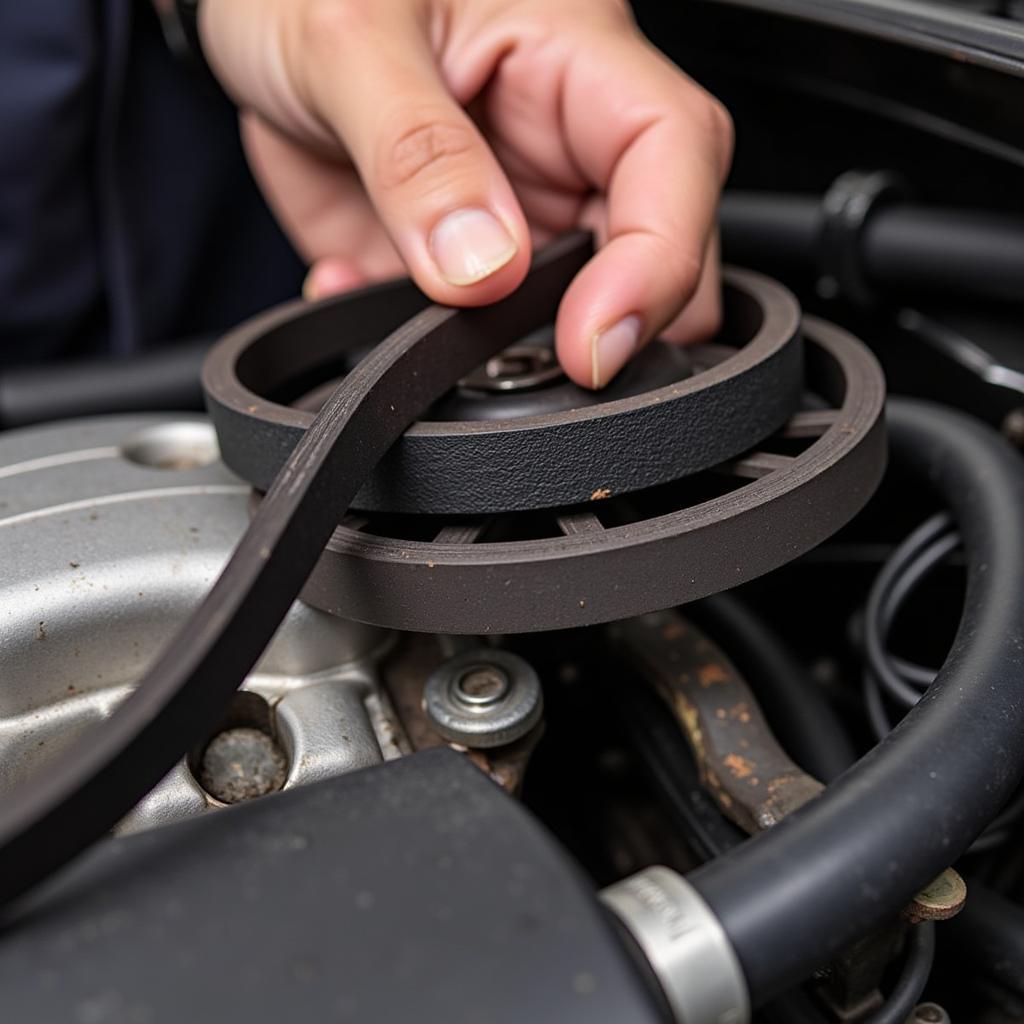A broken or slipping fan belt can lead to overheating, battery drainage, and other serious car problems. Knowing how to fix a fan belt is a valuable skill for any car owner. This guide provides a comprehensive, step-by-step approach to diagnosing and replacing a fan belt, empowering you to tackle this common car issue.
Identifying a Faulty Fan Belt
Before diving into the repair, it’s crucial to confirm that the fan belt is indeed the problem. Several signs point to a faulty fan belt:
- Squealing noises: A high-pitched squealing sound, especially upon starting the engine or accelerating, often indicates a slipping fan belt.
- Overheating: The fan belt drives the water pump, which circulates coolant. A broken or slipping belt can disrupt this process, causing the engine to overheat.
- Dead battery: The fan belt also powers the alternator, which charges the battery. A broken belt can prevent the alternator from functioning, leading to a dead battery.
- Visible damage: Inspect the fan belt for cracks, fraying, or glazing. These are clear indicators that the belt needs replacement.
Similarly to how long does it take to fix a car radiator, addressing a fan belt issue promptly is key to preventing further damage.
 Inspecting Fan Belt for Cracks and Wear
Inspecting Fan Belt for Cracks and Wear
Gathering the Necessary Tools and Materials
Having the right tools makes the replacement process smoother. You’ll need:
- A new fan belt (check your car’s manual for the correct specifications)
- A set of wrenches and sockets
- A ratchet
- A fan belt tensioner tool (if required by your car model)
- Protective gloves
- Safety glasses
Step-by-Step Fan Belt Replacement Guide
Relieving the Tension
Most modern cars use a tensioner pulley to maintain proper fan belt tension. Locate this pulley and use the appropriate tool to relieve the tension. This usually involves rotating the tensioner against its spring pressure. Older cars may require loosening the alternator or other accessory mounting bolts.
Removing the Old Belt
With the tension relieved, carefully slip the old belt off the pulleys. Pay attention to the routing of the belt. Taking a picture or drawing a diagram before removing the belt can be helpful. Like fixing a baby car seat belt buckle, meticulousness is key.
Installing the New Belt
Route the new belt over the pulleys, following the diagram or picture you took earlier. Ensure the belt is seated correctly in the grooves of each pulley.
Restoring the Tension
Once the new belt is in place, slowly release the tensioner pulley or tighten the mounting bolts, depending on your car’s setup. The belt should have proper tension – not too tight, not too loose. A good rule of thumb is that the belt should deflect about half an inch when pressed firmly midway between two pulleys.
Troubleshooting Common Issues
Belt Slips After Replacement: If the belt slips after replacement, double-check the routing and tension. Ensure the belt is properly seated on all pulleys.
Difficulty Removing the Old Belt: If the old belt is difficult to remove, try using a penetrating oil on the pulley bolts.
Knowing how to fix a fan belt yourself can save you time and money. However, if you’re uncomfortable working on your car’s engine, it’s always best to consult a qualified mechanic. Similar to a hauck comfort fix car seat review, understanding the mechanics of your vehicle is essential for its maintenance.
Conclusion
Fixing a fan belt can seem daunting, but with the right tools, knowledge, and a bit of patience, it’s a manageable task for most car owners. This guide provides a comprehensive overview of the process, from identifying a faulty belt to replacing it correctly. Regularly inspecting and maintaining your fan belt can help prevent costly repairs down the line. For personalized support or if you encounter any difficulties, feel free to connect with AutoTipPro at +1 (641) 206-8880 or visit our office at 500 N St Mary’s St, San Antonio, TX 78205, United States.
FAQs
-
How often should I replace my fan belt? Most manufacturers recommend replacing the fan belt every 60,000 to 100,000 miles, but it’s always best to check your car’s manual for specific recommendations.
-
What causes a fan belt to break? Several factors can contribute to fan belt failure, including age, wear and tear, exposure to extreme temperatures, and misalignment. This can be similar to a car still overheating after fixing leak.
-
Can I drive my car with a broken fan belt? It’s strongly advised not to drive with a broken fan belt, as it can lead to engine overheating and other serious damage.
-
How much does it cost to replace a fan belt? The cost of replacing a fan belt varies depending on the make and model of your car and labor costs.
-
What tools do I need to replace a fan belt? You’ll need a new fan belt, a set of wrenches and sockets, a ratchet, a fan belt tensioner tool (if required), gloves, and safety glasses. Consider scenarios like when a baby fixing car.
-
How can I tell if my fan belt is too tight or too loose? A properly tensioned fan belt should deflect about half an inch when pressed firmly midway between two pulleys. A baby fixing car highlights the importance of proper mechanics.
-
What should I do if my fan belt keeps squealing after replacement? Double-check the routing and tension of the belt and ensure it’s properly seated on all pulleys. If the problem persists, consult a mechanic.




Leave a Reply